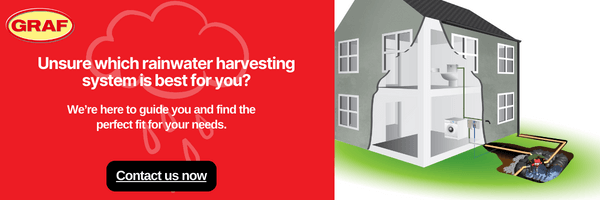When it comes to using rainwater for domestic purposes, there are two types of systems that you will have to consider. A direct feed and an indirect feed. Both supply a property with precious rainwater and both include a mains water back up, however they feed the appliances in two completely different ways.
A direct feed system pumps water from the rainwater harvesting tank directly to the toilets, washing machine and/or outside tap. This type of system has a mains water back up system which has to include an air gap between the mains water connection and the rainwater tank, to meet regulations which prevent against cross contamination of rainwater into the mains water pipework. This is typically done with a length of pipe from somewhere in the house going back to the tank, which contains a float switch from a mains water back unit. This comprises of a tun-dish to give you the air gap and a solenoid valve connected to a float switch which is inside the tank, so as the rainwater level drops in the tank the float switch drops. The solenoid valve then opens up and this allows mains water to flow through the tun-dish and by gravity supply flow back through the pipe to the tank, thereby topping up the main underground tank out in the garden with mains water. It keeps filling with mains water until the float switch rises as the water level rises and then when the float switch is in the upright position the solenoid valve will close and the mains water top up will stop.
If you’re looking to install a direct feed system, it’s important to consider the length of distance between where the mains water back up unit is inside the house and the underground tank. From that mains water top up unit the water is only being supplied by gravity pressure so the speed it travels from the air gap arrangement to the underground tank can be quite slow. This means that the system can be topping up with mains water for what appears to be a very long time. This depends on the type of tank, the position the float switch is tied off within the tank and the amount of height level distance between the mains water back up unit and the tank. Obviously the higher the mains water back up unit compared to the tank, the more head of pressure is built up as the mains water travels through the pipe and into the underground tank. Once the mains water has got to the tank, all water supplied to the toilets and the washing machine and any other outlet, is supplied by the submersible pump in the underground tank. Now, it is possible to add additional items such as a level gauge so that you can see how much water is in the tank but normally these are not related to the mains water top up functionality on these systems. In some systems they can be, but quite often they are just to show the occupier of the house how much water is in the tank and it is an added visual item to the system.
An indirect feed system works in a similar way to a direct feed system, however instead of pumping rainwater directly to the appliance, the submersible pump inside the tank pumps rainwater to a header tank in the roof space of the property. A header tank is installed in the roof space and it has two connections; one for mains water and one for rainwater. There are various types of header tanks but the idea in principle is to maximise the amount of rainwater used before switching over to mains water if necessary, if rainwater is not available in the underground tank. So, when rainwater is available the submersible pump will pump from the tank up via the black and green rainwater pressure pipe into the roof space and fill the header tank with rainwater. From there, on demand when toilets are flushed, the valve on the system opens and the rainwater will be supplied via gravity feed from the header tank in the loft down to fill up the toilet. When the rainwater level drops inside the tank and isn’t available for the pump to send it to the header tank the pumps dry running protection will kick in and the pump will shut off. That will mean the rainwater ball valve in the header tank will continue to drop and no water will be supplied. At this point the mains water top up would kick in which would be set at a lower position inside the header tank, and when that valve drops down that will open up the mains water supply and mains water is used to top up the header tank.
The benefit of this system is that the mains water back up supply is not reliant on power so if there is a power cut in the property the pump wouldn’t work inside the tank and the water level in the header tank would drop. However, on a standard header tank system if it has a mechanical valve not a motorised valve, then mains water will still be allowed to top up the header tank and that can then be supplied to the toilets under gravity pressure. There are alternatives that require power so it’s not one rule fits all, so it’s important to understand how each individual header tank system works. More often than not on a indirect system there is a way of ensuring there’s a continued water supply with or without power so it works whether there is a power cut or a pump failure, so there won’t be a time when the toilets aren’t being supplied with water.
Rainwater harvesting is a simple concept, yet so many people still don’t understand how it works and how they can benefit from it and with the UK expected to suffer from water shortages within the next 20-25 years, it is now more important than ever to start putting rainwater to good use.



